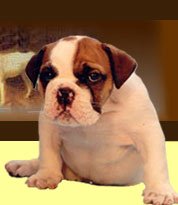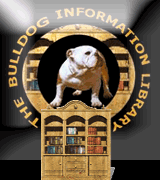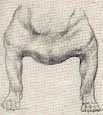The English Bulldog
Breed Standard
(part 3)
.
.
.
detailed and explained by Catherine Marien
Complete with the latest official amendments,
September 2003 (in brown in the text)
Neck
Should be moderate in length (rather short than long), very thick, deep and strong. It should be well arched at the back (presenting a convexe profile at the top), with much loose, thick and wrinkled skin about the throat, forming a double dewlap well divided on each side, from the lower jaw to the chest.
double dwelap,
well divided on each side
correct neck arched at the back, presenting
a convexe line. Short, but very thick and strong
Forequarters
The shoulders should be broad, sloping and deep, very powerful and muscular, and giving the appearance of having been "tacked on" to the body. If the shoulder is not sloping enough (i.e. too upright), the movement will be stilted and uneven.
The brisket should be capacious, round and very deep from the top of the shoulders to the lowest part where it joins the chest, and be well let down between forelegs.
It should be large in diameter and round behind the forelegs (not flat-sided, the ribs being well rounded).
The forelegs should be very stout and strong, set wide apart, thick, muscular, and straight, with well-developed forearms, presenting a rather bowed outline, but the bones of the legs should be large and straight, not bandy or curved. The inner forelegs will form a near square from the top of the legs and across.
Faulty fronts:
A vertical rectangle between the front legs indicates that the front is too narrow.
They should be rather short in proportion to the hind-legs, but not so short as to make the back appear long, or detract from the dog's activity, and so cripple him. The elbows should be low, and stand well away from the ribs. The pasterns should be short, straight and strong.
A horizontal rectangle indicates that the front legs are too short.
Typical, well-balanced
front, broad and deep,
body swung low with
the legs placed wide and
the feet planted firmly
Although well muscled,
far too narrow,
lack of chest and
too close a stand.
Chippendale front,
very poor front
showing general weakness
with bowed legs and
feet turned out excessively
Loose font and slack
shoulders, scant muscular
development, lack of
power, small bones
Body
The chest should be very wide, laterally round, prominent, and deep, making the dog appear very broad and short-legged in front. The back should be short and strong, very broad at the shoulders, and comparatively narrow at the loins.
Poorly built body, lacking pear-shaped
outline instead, straighter-bodied outline,
more suggestive of the terrier
Correct body with pear-shaped outline,
heavy front and lighter hindquarters,
and powerful shoulders and neck
Viewed from above, the correct Bulldog, should show the characteristic wedge or pear-shaped outline. The body is broad and heavy in front, narrower and lighter behind, as illustrated on the right. The powerful shoulders and neck are particularly noticeable in such a top view.
Correct body with typical roach (wheel back) which rises over the loins then curves down to the base of the low-set tail
Incorrect flat backline
(characteristic of
the Terrier)
Sway-back,
exaggeration of the
roach, found in dogs
lacking firm musculation
Camel back,
excessively
arched back
There should be a slight fall to the back close behind the shoulders (its lowest part), whence the spine should rise to the loins (the top of which should be higher than the top of the shoulders), then curving again more
The body should be well ribbed up behind, with the belly tucked up and not pendulous.
Belly well tucked-up
behind the ribs
Chest and brisket lack depth,
lack of tuck-up at loin
suddenly to the tail, forming an arch - a distinctive characteristic of the breed - termed "roach back".
Original idea, design and development by C. Marien-de Luca. No part of bulldoginformation.com may be copied, distributed, printed or reproduced on another website without the owner's written permission. Please feel free to link from your site to any of the pages on this website in a non-frame presentation only.
















